Lumix
Lumix is Panasonic's brand of digital cameras, ranging from pocket point-and-shoot models to digital SLRs.
 Lumix logo | |
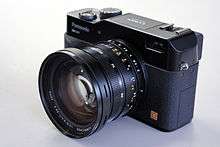 Panasonic Lumix DMC-LC1 (2004) | |
| Product type | Digital cameras |
|---|---|
| Owner | Panasonic |
| Country | Japan |
| Introduced | 2001 |
| Ambassador(s) | Marco Reus, Ayumi Hamasaki, Karena Lam |
Compact digital cameras DMC-LC5[1] and DMC-F7[2] were the first products of the Lumix series, released in 2001.
Most Lumix cameras use differing releases of the Panasonic Venus Engine for digital image processing; the original version (2002) was followed by II (2004), Plus (2005), III (2006), IV (2008), HD, V (2009) and VI, HD II, FHD (2010).
Some Lumix models are branded with Leica lenses (e.g. Nocticron or Elmarit lenses), although Leica does not manufacture the lenses. Others are rebranded as Leica cameras with different cosmetic stylings.
Panasonic showed a prototype of a planned 3D Lumix camera in September 2011,[3] saying that it would have twin 4x zoom lenses with folding optics and optical image stabilization for both video and still images.[3]
Panasonic collaborated with Sigma and Leica to form the L-mount Alliance on 25 September 2018, and licence the L-mount system for their own lines of lenses and cameras.[4] in 2019 Panasonic announced the release of its new S-series line of mirrorless cameras.[5]
Model lines
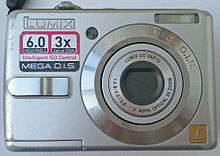
Some cameras are available in a choice of color, indicated by a suffix letter: K is black, S silver, A blue, R red, W white. Most lower-priced models have small sensors of about 10.2 mm / 1/2.5". More expensive ones often have sensors of about twice the area, 14.1 mm to 15.4 mm / 1/1.65" to 1/1.8". dSLRs and Micro Four Thirds system cameras have much larger sensors. Larger sensors produce a better image signal-to-noise ratio and better dynamic range. The GH series of Micro Four Thirds cameras, and the LX100, have a unique "multi-aspect" sensor, that is larger than the lens image circle. This allows three different aspect ratios, 4:3, 3:2 and 16:9, to be used natively. As a result, the image diagonal remains the same in all three aspect ratios and provides full coverage of the sensor, and a larger field of view with higher resolution than one would get by simply cropping the 4:3 aspect to the narrower ratios.
Current
- DMC-FX: ultra-compact high-end, relatively typical cameras. Unlike most of the other Lumix lines, the FX series tends to have a more stylish look (as opposed to the generic silver or black), targeted at social photography. The FX30 was announced as the world's slimmest camera with a 28 mm equivalent wide-angle lens. The FX500 is the first Panasonic to feature a touch-screen interface.
- DMC-FZx (excluding DMC-FZx0 models): compact ultra-zoom higher-end cameras. These cameras are described as compact but are relatively large, have extensive controls (although models earlier than the FZ7 do not have manual focus), and long zoom ranges, typically 12x with extending zoom lens.
- DMC-FZxx: bridge digital cameras, resemble digital SLRs in many ways, but have a non-interchangeable, non-extending zoom lens. The FZ70/72 bridge camera is as large and heavy as a medium-sized DSLR, has a 1/2.3" sensor, a very wide zoom range (20-1200mm, 60x) and extensive manual controls, including fully manual focus, and zoom rings on the lens. The FZ200 has a 25–600 mm lens (35 mm equivalent) superzoom with f/2.8 light sensitivity through the whole range and shoots 12 MP stills and full HD video with 24/30/50/60 fps and 120 or 200 fps for slow motion. FZ1000 uses a 1" sensor (as does the Sony RX10). Compared to the RX10, the FZ1000 can shoot 4K video, is priced considerably lower and has double the optical zoom, but no built-in ND Filter and no fixed aperture.[6]
- DMC-G: Micro Four Thirds system line, advertised as a "reinvented DSLR" without mirror.
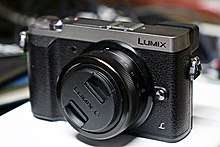 Panasonic Lumix DMC-GX80/DMC-GX85/GX7 Mark II (2016)
Panasonic Lumix DMC-GX80/DMC-GX85/GX7 Mark II (2016)- DMC-G: standard mirrorless line.
- DMC-GF: distinguished from the DMC-G line by the lack of an integrated electronic viewfinder.
- DMC-GH: marketed as their higher-end mirrorless line, also with increased video capabilities.
- DMC-GM: marketed as the smallest interchangeable lens camera.
- DMC-GX: enthusiast camera with capabilities between the DMC-GF line and the standard DMC-G line.
- DC-S: full frame mirrorless line using the new L-mount. The S1 was released in 2019 as the world's first full frame camera capable of internal 4K/60p recording, in addition to 4:2:2 10-bit external recording in 4K/60p. The S1R was released at the same time. Marketed towards stills photographers with the highest resolution full frame mirrorless camera at 47.3MP. In fall of 2019, Panasonic launched the S1H. Marketed as a "cine camera", it's the world's first full frame camera capable of 6K video recording, and internal 10-bit 4K/60p recording. In the future, the S1H will also be capable of external RAW with Atomos recording monitors.[7]
 Panasonic Lumix S1R with prime lens 50 mm f/1.4
Panasonic Lumix S1R with prime lens 50 mm f/1.4 - DMC-L: DSLR line. It uses the Four Thirds system lens mount and, along with the Olympus E-330, was one of the first DSLRs capable of displaying a live image view on the LCD screen.
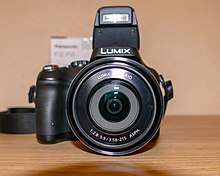 Panasonic FZ72
Panasonic FZ72 - DMC-LS: cheapest line, budget plastic compact cameras powered by two AA batteries.
- DMC-LX: compact high-end camera line, with full manual exposure and focus controls (with joystick control rather than focus ring), and RAW recording, unusual in compact cameras.
- DMC-LZ: budget, but more advanced and with more user control than many other digital compact cameras. The most notable feature is a 6x (37–222 mm) optical zoom range.
- DMC-SZ: mid-level compact superzoom cameras. SZ-series stands for "style zoom". Introduced in January 2012, these cameras use the 25 mm ultra-wide angle LEICA DC VARIO-ELMAR lens, have a 10x optical zoom, and shoot high definition video.[8] Models include the SZ1, SZ5, SZ7 and SZ9.
- DMC-TS / DMC-FT: waterproof, shockproof and dustproof point and shoot cameras.
- DMC-TZ: (Travel Zoom) compact, point and shoot zoom cameras with image stabilization. The TZ1 uses folded optics, with a prism. TZ1's successors use a traditional design without folded optics, hence the barrel extends further out during operation.[9] The TZ series stands out against other compact digital cameras by achieving a 30x optical zoom with a 24 mm wide angle lens (equivalent to 35 mm camera) in a small, compact body.
- DMC-ZS: alternative names for certain DMC-TZ models, used for marketing in North America.
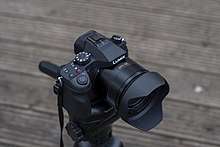 FZ1000
FZ1000
Discontinued
- DMC-FS: ultra-compact mid-range, relatively typical cameras. The FS range was launched in January 2008.
- DMC-LC: medium-compact-size, mid-range, but also included high-end models.
Product development highlights
- 2001
- Released high-end compact camera DMC-LC5 equipped with "Leica · DC · VARIO · SUMIKRON lens"
- Released Ultra Compact Camera DMC-F7 equipped with "Leica · DC · Barrio · Elmarito lens"DMC-F1
- 2002
- "Venus Engine" installed (DMC-F1, DMC-FZ1)
- World's first "optical 12x zoom" mounted (DMC-FZ1)
- "Image stabilization (MEGA OIS)" mounted (DMC-FZ1)
- 2003
- World's first Ultra Compact Camera equipped with "Image stabilizer (MEGA OIS)" (DMC-FX5, DMC-FX1)
- 2004
- "Venus Engine II" installed (DMC - FX 7, DMC - FX 2, DMC - FZ 20)
- "2.5-inch power LCD" mounted (DMC-FX 7)
- Year 2005
- "Venus Engine Plus" installed (DMC-FX 8, DMC-FX 9)
- "Free angle liquid crystal" mounted (DMC - FZ 30)
- World's first "16: 9 CCD" mounted (DMC-LX 1)
- "High-definition power LCD" mounted (DMC-FZ30, DMC-FX8, DMC-FX9)
- 2006
- World's smallest single lens type digital camera with "optical 10x zoom" (DMC-TZ1)
- "Venus Engine III" & "Flexible collapsible lens" (DMC-TZ1)
- World's first successful mass-production of "ultra-high refraction glass", "wide-angle 28 mm lens" mounted (DMC-FX 01)
- World's first "motion recognition" installed (DMC-FX 07)
- "Four Thirds mounting mechanism" & "Leica D Barrio · Elmarito lens" adopted (DMC-L1)
- "Non-dust system" & "Live MOS sensor" loaded (DMC-L1)
- 2007DMC-FX 100
- World's smallest , "optical 10 × zoom" mounted with a wide-angle 28 mm mounted monocular type digital camera (DMC-TZ 3)
- World's thinnest with a wide-angle 28 mm mounted model (DMC-FX 30)
- "3.0 high-definition power LCD" mounted (DMC-FX50)
- World's first "wide-angle 28 mm loaded model" equipped with "12.2 million pixel CCD" (DMC-FX100)
- World's first "Intelligent Auto (iA)" installed (DMC-FX33, DMC-FX55) DMC-L 10
- 2008
- World's first digital SLR camera equipped with "Free Angle LCD" & "Face Recognition AF / AE" (DMC-L10, DMC-L10K)
- "Leica D Barrio · Elmer Lens" adopted (DMC - L 10)
- World's smallest , "optical 10 × zoom" mounted with a wide-angle 28 mm mounted monocular type digital camera (DMC-TZ 5)
- "Venus Engine IV" installed (DMC-FX 35)
- "Dark portion correction" & "Digital red eye correction" mounted (DMC - FX 35)
- World's first "touch motion tracking AF / AE" mounted (DMC-FX 500)
- "Chasing focus" is installed (DMC-FX 37)
- "Leica · DC · Vario · Sumikuron lens" mounted (DMC-LX 3)
- "Venus Engine HD" loaded (DMC-G1)
- " Micro Four Thirds Mounting Mechanism " & "Lumix G Barrio Lens" adopted (DMC-G1)
- By adopting "mirrorless structure", it achieves the world's smallest and lightest with digital single lens camera (DMC-G1)
- "W Live View" loaded (DMC-G1)
- 2009
- Optical 12 × zoom mounted Monocular type digital camera realizes the world's smallest (DMC-TZ 7)
- World's first compact digital camera with " AVCHD Lite movie shooting function" (DMC - TZ 7, DMC - FT 1)
- "Waterproof, dustproof, anti-shock function & bending type lens" adopted (DMC-FT1)
- "Leica · DC · Vario · Elmer Lens" mounted (DMC - TZ 7, DMC - FT 1)
- Equipped with "personal recognition" (DMC - FX 40, DMC - FX 550, DMC - TZ 7, DMC - FT 1)
- "Venus Engine V" installed (DMC - FX 40, DMC - FX 550)
- Equipped with "New Shake Reduction (POWER OIS)" (DMC-FX60, DMC-ZX1, DMC-FP8, DMC-FZ38)
- Equipped with "speed focus" (DMC - FX 60, DMC - ZX 1, DMC - FP 8, DMC - FZ 38)
- The world's thinnest 0.3 mm ultra-thin aspheric glass lens is mounted, achieving the thinnest in Lumix history (DMC-FX 60)DMC-GF 1
- Flash built-in lens interchangeable digital camera realizes world's smallest and lightest(DMC-GF1)
- 2010
- "Venus Engine VI" installed (DMC-FX66)
- "Venus Engine HD II" installed (DMC-ZX3, DMC-TZ10, DMC-FT2)
- "DMC - FX 66, DMC - ZX 3, DMC - TZ 10, DMC - FT 2" equipped with "super resolution technology"
- Equipped with "iA zoom" (DMC-FX66, DMC-ZX3, DMC-TZ10, DMC-FT2)
- Thin and bent type lenses are adopted, achieving the thinnest in the history of luminescence (DMC-FP1)
- Brepita mode is installed (DMC - FX 70)
- Finder-equipped lens interchangeable digital camera realizes world's lightest weight (DMC-G10)
- "Venus Engine FHD" installed (DMC-FZ100, DMC-LX5, DMC-FX700)
- "MOS sensor" mounted (DMC-FZ100, DMC-FX700)
- Realizes the world's fastest , high-speed continuous shooting of about 11 frames / sec (DMC-FZ100)
- 2011
- "Nano surface coating" which reduces flare and ghost is adopted (DMC - TZ 20, DMC - FZ 150, DMC - FZ 48)
- Realizes the world's fastest , high-speed continuous shooting of about 12 frames / sec (DMC-FZ150)
- "High sensitivity MOS sensor" which improved light receiving sensitivity from conventional MOS is installed (DMC - FZ 150)
- "High speed CCD" which speeds up reading speed from conventional CCD is installed (DMC - FZ 48)
- 2012
- The world's thinnest , as thin as about 20.2 times zooming digital camera realized about 28.2 mm (DMC-TZ30)
- Newly developed "new high sensitivity MOS sensor" mounted (DMC-TZ30, DMC-SZ7)
- As world's first lens integral digital camera realized F 2.8 brightness at 600 mm (DMC-FZ 200)
- World's first realization of F1.4 brightness as a lens integrated digital camera (DMC-LX 7)
- 2013
- "5-axis hybrid camera shake correction" & "tilt correction" mounted (DMC-TZ40)
- Equipped with "NFC (short range wireless communication)" aimed at cooperation with smartphones (DMC - TZ 40)
- 2019
- S1, S1R, and S1H full-frame mirrorless cameras released
Model history
| Type | Venus Engine | |||||||||||||
|---|---|---|---|---|---|---|---|---|---|---|---|---|---|---|
| Non-installing | Venus I
(2002) |
Venus II
(2004) |
Venus Plus
(2005) |
Venus III
(2005) |
Venus IV
(2008) |
Venus HD
(2008) |
Venus V
(2009) |
Venus VI
(2010) |
Venus HD II
(2010) |
Venus VII FHD
(2010, upgraded in 2012, 2013) |
Venus IX
(2014) |
Venus X
(2017) |
Venus XI
(2019) | |
| High-end Ultra-Compact |
FX100 | FX150 | FX580 / FX550 | FX700 | ||||||||||
| Ultra-Compact, Wide-angle | FX01 | FX50 / FX30 / FX55 / FX33 | FX35 / FX500 | FX48 / FP8 / ZX1 / FX550 | FX66 | ZR3 / ZX3 | FX78 | |||||||
| Ultra-Compact | F7 | F1 / FX5 / FX1 | FX7 / FX2 | FX8 / FX3 / FX9 | FX12 | FS3 / FS5 / FS6 / FS7 / FS15 / FS20 / FS25 | ||||||||
| High-end Compact |
LC5 | LC1 | LX1 | LX2 | LX3 | LX5 / LX7 | LX100 | |||||||
| Compact, Wide-angle, Large Zoom | TZ1 / TZ2 / TZ3 | TZ4 / TZ5 / TZ15 / TZ50 / ZS1 | ZS3 | ZS5 / ZS8 | ZS7 | ZS10 / ZS15 / ZS20 / ZS30 | ||||||||
| Compact, Medium Zoom |
LZ1 / LZ2 / LZ3 / LZ5 | LZ6 / LZ7 | LZ8 / LZ10 | |||||||||||
| Bridge, Ultra Zoom |
FZ1 / FZ2 / FZ10 | FZ3 / FZ5 / FZ7 / FZ30 / FZ20 | FZ50 / FZ18 / FZ8 | FZ28 | FZ35 / FZ38 | FZ40 / FZ45 | FZ100 / FZ48 / FZ150 / FZ200 | FZ1000 | ||||||
| Compact | LC40 / LC20 | LC33 / LC43 / LC70 | LS1 / LS2 | LS60 / LS75 / LS80 | LS85 | |||||||||
| Four Thirds | L1 / L10 | |||||||||||||
| Micro Four Thirds | G1 / GH1 / GF1 | G2 /G10 | GH2 / GF2 / GF3 / G3 / GX1 / GH3 / G5 / G6 | GH4 / G7 | G9 / GH5 / GH5S /GX9 | |||||||||
| Full Frame L-mount | S1 / S1R / S1H | |||||||||||||
| One Inch sensor | ||||||||||||||
| Waterproof, shockproof and dustproof | TS10 | TS1 | TS2 | TS3 / TS4 | ||||||||||
Note: Years shown in the header row are Venus Engine release years, not the camera release years.
Note: The Venus engine of the S-series full frame cameras is only referred to as "the new Venus Image Processor" by Panasonic.
See also
- Panasonic
- Leica Camera
- Comparison of digital single-lens reflex cameras
References
- DMC-LC5 (Japanese)
- DMC-F7 (Japanese)
- Stephen Shankland, CNET. "Panasonic shows off 3D Lumix camera prototype." September 2, 2011. Retrieved September 7, 2011.
- "Panasonic, Leica and Sigma unveil the L-Mount mirrorless alliance". Engadget. Retrieved 2020-02-17.
- "Panasonic S1R and Panasonic S1 35mm Full-frame Mirrorless Cameras | Photography Blog". www.photographyblog.com. Retrieved 2020-02-17.
- Richard Butler. "Panasonic Lumix DMC-FZ1000 First Impressions Review". Retrieved June 12, 2014.
- "Panasonic S1H Full Specifications Announced". Newsshooter. 2019-08-28. Retrieved 2020-02-17.
- "Panasonic announces DMC-SZ7 and DMC-SZ1 mid-level compact superzooms," Digital Photography Review.
- Panasonic Lumix DMC-TZ3 Review, Digital Camera resource page, Jeff Keller, April 7, 2007. Accessed on line April 28, 2008.
External links
| Wikimedia Commons has media related to Panasonic Lumix cameras. |
- Official site with details of current cameras
- Thorsten Overgaard's User Report of the Panasonic DMC LC 1 and Leica Digilux 2
